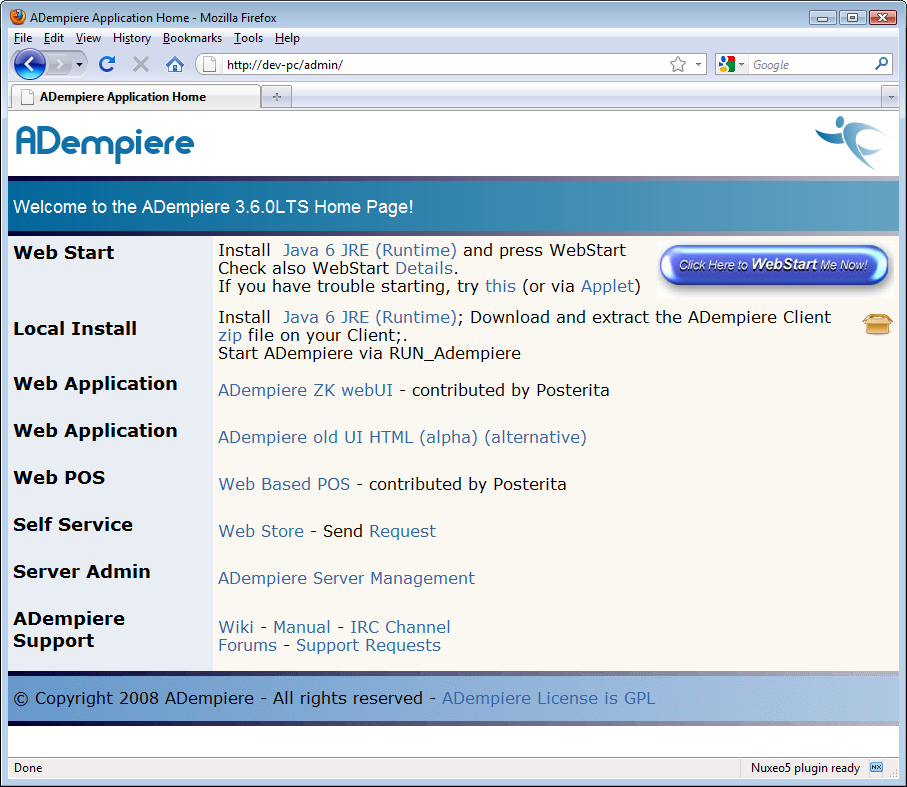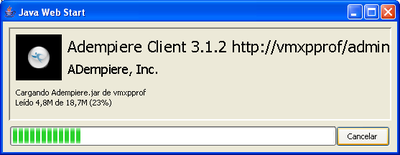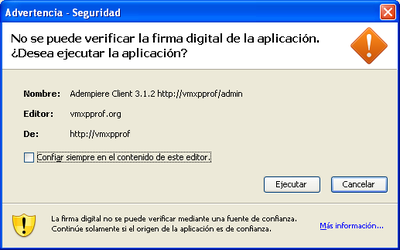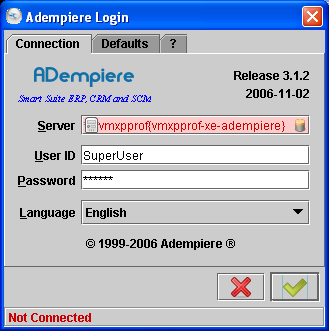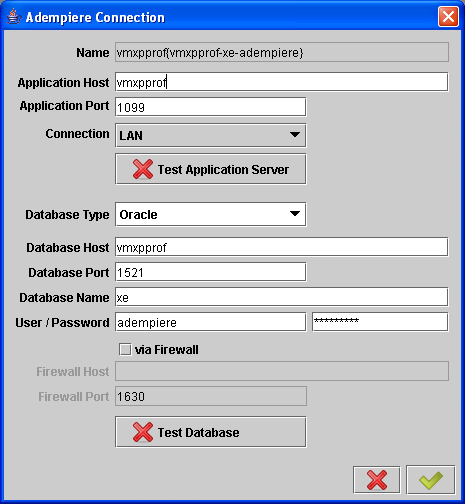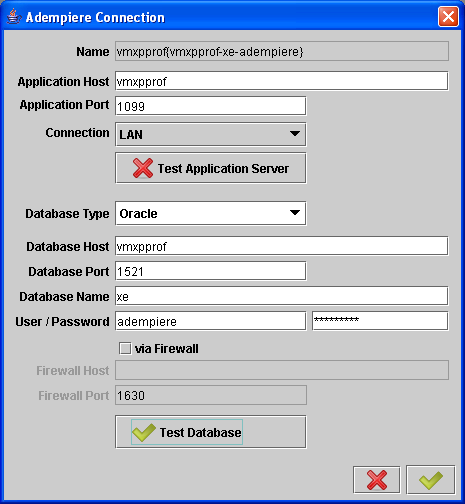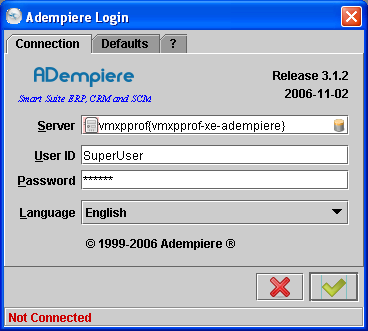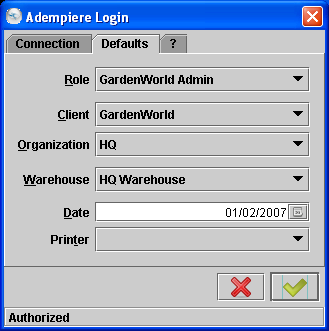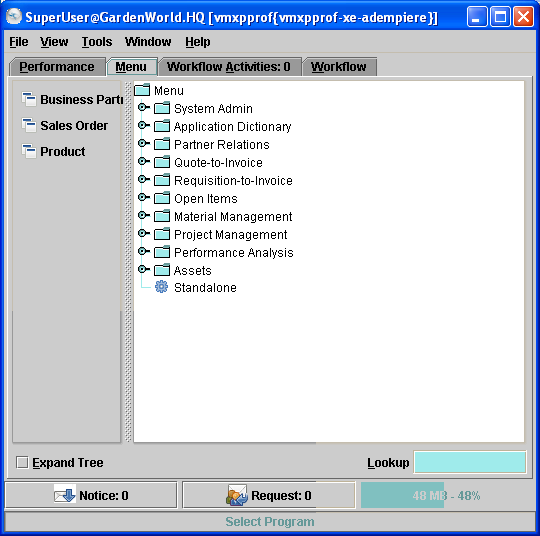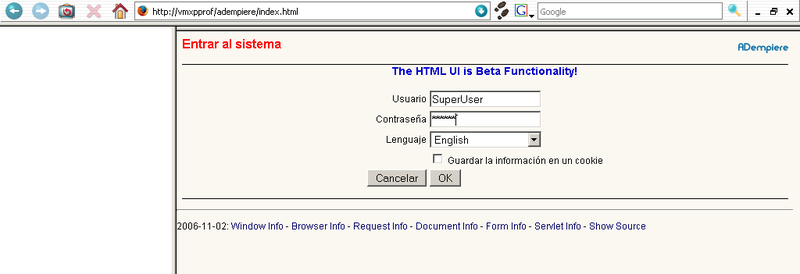Difference between revisions of "Launching the ADempiere Application"
m (→Installing the ADempiere Client: Updating graphics and minor cleanup) |
m |
||
| Line 1: | Line 1: | ||
| − | {{Breadcrumb|next=Logging In to the Client}} | + | {{Breadcrumb|Table of Context|Getting Started|next=Logging In to the Client}} |
[[Category:User documentation]] | [[Category:User documentation]] | ||
{{Cleanup}} | {{Cleanup}} | ||
| − | The ADempiere Application runs as a ''client'' that communicates with the ADempiere Application Server. It can run on the server, on a remote machine or via a web interface. | + | The ADempiere Application runs as a ''client'' that communicates with the ADempiere Application Server. It can run on the server, on a remote machine or via a web interface. This article describes how to install the client software and launch the client application. |
| − | == | + | == Prerequisites == |
| − | + | Before running the client, ensure the the ADempiere Application Server is running on the Server computer. See [[Launching the Application Server]] for details. | |
| − | + | ||
| − | + | ||
| − | + | ||
| − | + | Each client/remote computer will need to have Java installed Visit [http://www.java.com http://www.java.com] to download and install the latest version. | |
| − | + | ||
| − | + | ||
| − | [[Image:Adempiere_Home.png|center | + | {{Note|The Client software is automatically installed on the Server as part of the Server Install process. Depending on your operating system and installation process, you can access the Client software on the Server from a shell directly (<Adempiere_Home>/utils/RUN_ADempiere.bat/sh) or via a system menu or desktop shortcut. You can also use the process described below.}} |
| + | |||
| + | == Installing the ADempiere Client == | ||
| + | |||
| + | To access the ADempiere Application Server from a browser, point your browser to your server URL (<nowiki>http://<your server name, IP or URL>:<your port number>/admin</nowiki>) | ||
| + | |||
| + | [[Image:Adempiere_Home.png|center]] | ||
To install the ADempiere client on a remote computer, you have two options: | To install the ADempiere client on a remote computer, you have two options: | ||
==='''Option 1: Web Start'''=== | ==='''Option 1: Web Start'''=== | ||
| − | |||
| − | |||
The WebStart option automatically makes sure that the client computer will use the latest version. This is very handy in large installations as you will only need to update the software on the server and all the clients will automatically update their local copies the next time the client is launched. | The WebStart option automatically makes sure that the client computer will use the latest version. This is very handy in large installations as you will only need to update the software on the server and all the clients will automatically update their local copies the next time the client is launched. | ||
| Line 41: | Line 40: | ||
**extract the file content to a local directory. | **extract the file content to a local directory. | ||
| − | + | Refer to the [[Getting Started#Manual Installation|Manual Installation]] Instructions for your operating system as the installation process is similar to the installation of the server software. Specifically, you will need to set the following system environment variables: | |
* '''JAVA_HOME''' | * '''JAVA_HOME''' | ||
* '''ADEMPIERE_HOME''' | * '''ADEMPIERE_HOME''' | ||
* '''PATH''' | * '''PATH''' | ||
| − | |||
| − | |||
| − | |||
| − | |||
| − | |||
| − | |||
| − | |||
| − | |||
| − | |||
| − | |||
| − | |||
| − | |||
| − | |||
| − | |||
| − | |||
| − | |||
| − | |||
| − | |||
| − | |||
| − | |||
| − | |||
| − | |||
| − | |||
| − | |||
== Start the ADempiere Client== | == Start the ADempiere Client== | ||
| Line 109: | Line 84: | ||
*[[ADempiere_Installing|Installing ADempiere]] Tutorial on how to setup and configure ADempiere. | *[[ADempiere_Installing|Installing ADempiere]] Tutorial on how to setup and configure ADempiere. | ||
*[[Tutorials|Tutorials]] on many things from basic to advanced. | *[[Tutorials|Tutorials]] on many things from basic to advanced. | ||
| + | |||
| + | == Troubleshooting Tips == | ||
| + | |||
| + | If you did not set the environment variables, you might receive an error message with the '''JAVA_HOME''' or '''ADEMPIERE_HOME''' variables as not been set. | ||
| + | |||
| + | Windows... | ||
| + | * Set the '''JAVA_HOME''' system environment variable to your java installation directory e.g. ''C:\jdk1.5.0_05'' | ||
| + | * Set the '''ADEMPIERE_HOME''' system environment variable to ''C:\Adempiere'' | ||
| + | |||
| + | Linux... | ||
| + | * Set the '''JAVA_HOME''' system environment variable to ''/usr/lib/jvm/java-6-sun/jre'' if that's where your java is. | ||
| + | |||
| + | For Debian based systems do this to check | ||
| + | ls -l /etc/alternatives/java | ||
| + | |||
| + | Use this command | ||
| + | export JAVA_HOME=/usr/lib/jvm/java-6-sun/jre | ||
| + | |||
| + | You can also set this in ~/.bashrc so it is set on each login. | ||
| + | * Set the '''ADEMPIERE_HOME''' system environment variable to ''/opt/Adempiere'' if that is the local directory you unzipped to. | ||
| + | * Make the shell script that starts Adempiere client runable, by giving it the eXecute attribute for All users. | ||
| + | chmod a+x /opt/Adempiere/RUN_Adempiere.sh | ||
| + | |||
| + | * Add ''%JAVA_HOME%\bin;%ADEMPIER_HOME%\lib;'' to your '''PATH''' system environment variable. | ||
Revision as of 04:40, 21 July 2010
⇐ Table of Context{{#if: Getting Started| | Getting Started }}{{#if: | | [[{{{3}}}]] }}{{#if: | | [[{{{4}}}]] }}{{#if: | | [[{{{5}}}]] }} | Launching the ADempiere Application{{#if: Logging In to the Client| | Logging In to the Client }} ⇒
| This article may require cleanup to meet the Wiki Documents standards. It may contain obsolete information or is in need of organization. Please improve this page if you can. |
The ADempiere Application runs as a client that communicates with the ADempiere Application Server. It can run on the server, on a remote machine or via a web interface. This article describes how to install the client software and launch the client application.
Contents
Prerequisites
Before running the client, ensure the the ADempiere Application Server is running on the Server computer. See Launching the Application Server for details.
Each client/remote computer will need to have Java installed Visit http://www.java.com to download and install the latest version.
Installing the ADempiere Client
To access the ADempiere Application Server from a browser, point your browser to your server URL (http://<your server name, IP or URL>:<your port number>/admin)
To install the ADempiere client on a remote computer, you have two options:
Option 1: Web Start
The WebStart option automatically makes sure that the client computer will use the latest version. This is very handy in large installations as you will only need to update the software on the server and all the clients will automatically update their local copies the next time the client is launched.
- From the Application Server web page, click on the WebStart button and you will see the WebStart Dialog:
- Then you will see the Security window:
- After you login, the application will start.
Option 2: Local Install
A local install makes a local copy of the client software that is not automatically updated. In order to perform the Local Install:
- click on the zip link and
- extract the file content to a local directory.
Refer to the Manual Installation Instructions for your operating system as the installation process is similar to the installation of the server software. Specifically, you will need to set the following system environment variables:
- JAVA_HOME
- ADEMPIERE_HOME
- PATH
Start the ADempiere Client
Start the ADempiere Client via the script RUN_Adempiere (.bat or .sh) . Then you will see the ADempiere Login window:
If you see that the server field background is red either:
- the validate connection on startup option that is set to off. You can check turn the option back on in the Preferences window once you log in. OR
- the database or application server has a problem. Click the Host/Server field and you will see the Connection dialog:
Check/correct the Application Host name and the Application Port (default is 1099).
- Press the Test Application Server button. If the application server is found, then information about the database server is returned.
- If the application server is not running, then
- enter the Database Host/server name,
- database name,
- the user name and
- the database password.
- After you filled up the fields, press the Test Database button to connect. You will see the Ok icon (in green) if the connection was successful.
- Click the Ok button to get back to the Login screen:
If the Host information is all white, you connected to the application server. If the left side is a bit red, you connected to the database, but not to the application server (the case in our example).

Note: For default Application Users and Passwords see Logging In to the Client.
- Click the Ok button to see the Login Default tab and then you can select the Role, Client and Organization.
- Press the Ok button and you will see the ADempiere menu:
The Adempiere Web Application Login (alternative)
You can login into the HTML client alternative via the ADempiere Web Application. To do it,
- click the Web Application link to start the HTML client. The log-in process is the same as with the Application Client.

Note: The HTML UI requires a maintainer.
Links
- Initial Client Setup For Business Client Setup in ADempiere.
- Server Setup that happened earlier.
- Installing ADempiere Tutorial on how to setup and configure ADempiere.
- Tutorials on many things from basic to advanced.
Troubleshooting Tips
If you did not set the environment variables, you might receive an error message with the JAVA_HOME or ADEMPIERE_HOME variables as not been set.
Windows...
- Set the JAVA_HOME system environment variable to your java installation directory e.g. C:\jdk1.5.0_05
- Set the ADEMPIERE_HOME system environment variable to C:\Adempiere
Linux...
- Set the JAVA_HOME system environment variable to /usr/lib/jvm/java-6-sun/jre if that's where your java is.
For Debian based systems do this to check
ls -l /etc/alternatives/java
Use this command
export JAVA_HOME=/usr/lib/jvm/java-6-sun/jre
You can also set this in ~/.bashrc so it is set on each login.
- Set the ADEMPIERE_HOME system environment variable to /opt/Adempiere if that is the local directory you unzipped to.
- Make the shell script that starts Adempiere client runable, by giving it the eXecute attribute for All users.
chmod a+x /opt/Adempiere/RUN_Adempiere.sh
- Add %JAVA_HOME%\bin;%ADEMPIER_HOME%\lib; to your PATH system environment variable.
